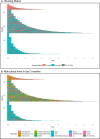Housing Stability and Hepatitis C Infection for Young Adults Who Inject Drugs: Examining the Relationship of Consistent and Intermittent Housing Status on HCV Infection Risk
- PMID: 32901411
- PMCID: PMC7704865
- DOI: 10.1007/s11524-020-00445-7
Housing Stability and Hepatitis C Infection for Young Adults Who Inject Drugs: Examining the Relationship of Consistent and Intermittent Housing Status on HCV Infection Risk
Abstract
Housing status affects drug using behaviors, but less is known about the relationship between housing patterns and hepatitis C virus (HCV) infection. HCV-negative young people who inject drugs (PWID) were enrolled into a prospective cohort (2003-2019) with quarterly study visits. We used Cox regression to estimate the independent association of recent housing status (housed vs. unhoused, housing stability, and housing trajectory) on HCV incidence. Among 712 participants, 245 incident HCV infections occurred over 963.8 person-years (py) (cumulative incidence 24.4/100 py). An inverse relationship between time housed and HCV incidence was observed (always unhoused 45.0/100 py, 95% confidence interval (CI) 37.1, 54.5; variably housed 18.0/100 py, 95% CI 15.0, 21.3; and always housed 7.0/100 py, 95% CI 3.0, 17.3). In Cox regression models controlling for confounders, those unhoused versus housed at baseline had a 1.9-fold increased infection risk (95% CI 1.4, 2.6). Those always unhoused versus always housed had a 1.5 times greater risk of HCV (95% CI 1.0, 2.3), and those spending a portion of time in stable housing a lower risk (adjusted relative hazard 0.05, 95% CI 0.3, 0.9) with a similar trend for those being housed for less time. Young adult PWID experiencing both recent and chronic states of being unhoused are at elevated risk for HCV infection. Importantly for this group of PWID, our findings indicate that some frequency of residential housing significantly reduces HCV infection risk.
Keywords: Hepatitis C virus; Housing status; People who inject drugs.
Figures




Similar articles
-
Modeling the impact of the COVID-19 pandemic on achieving HCV elimination amongst young and unstably housed people who inject drugs in San Francisco.Int J Drug Policy. 2024 Sep;131:104452. doi: 10.1016/j.drugpo.2024.104452. Epub 2024 Jun 22. Int J Drug Policy. 2024. PMID: 38910096 Free PMC article.
-
Homelessness, unstable housing, and risk of HIV and hepatitis C virus acquisition among people who inject drugs: a systematic review and meta-analysis.Lancet Public Health. 2021 May;6(5):e309-e323. doi: 10.1016/S2468-2667(21)00013-X. Epub 2021 Mar 26. Lancet Public Health. 2021. PMID: 33780656 Free PMC article.
-
Sexual behaviour as a risk factor for hepatitis C virus infection among people who inject drugs in Montreal, Canada.J Viral Hepat. 2019 Dec;26(12):1413-1422. doi: 10.1111/jvh.13194. Epub 2019 Sep 11. J Viral Hepat. 2019. PMID: 31433888
-
Assessing the feasibility of hepatitis C virus vaccine trials: results from the Hepatitis C Incidence and Transmission Study-community (HITS-c) vaccine preparedness study.Vaccine. 2014 Sep 22;32(42):5460-7. doi: 10.1016/j.vaccine.2014.07.091. Epub 2014 Aug 12. Vaccine. 2014. PMID: 25131726 Free PMC article.
-
Hepatitis C Reinfection in People Who Inject Drugs in Resource-Limited Countries: A Systematic Review and Analysis.Int J Environ Res Public Health. 2020 Jul 9;17(14):4951. doi: 10.3390/ijerph17144951. Int J Environ Res Public Health. 2020. PMID: 32659974 Free PMC article.
Cited by
-
Modeling the impact of the COVID-19 pandemic on achieving HCV elimination amongst young and unstably housed people who inject drugs in San Francisco.Int J Drug Policy. 2024 Sep;131:104452. doi: 10.1016/j.drugpo.2024.104452. Epub 2024 Jun 22. Int J Drug Policy. 2024. PMID: 38910096 Free PMC article.
-
The hepatitis C epidemic in Canada: An overview of recent trends in surveillance, injection drug use, harm reduction and treatment.Can Commun Dis Rep. 2021 Dec 9;47(12):561-570. doi: 10.14745/ccdr.v47i12a01. eCollection 2021 Dec 9. Can Commun Dis Rep. 2021. PMID: 35692566 Free PMC article.
-
Bridging the gap: Addressing disparities in hepatitis C screening, access to care, and treatment outcomes.World J Hepatol. 2024 Aug 27;16(8):1091-1098. doi: 10.4254/wjh.v16.i8.1091. World J Hepatol. 2024. PMID: 39221096 Free PMC article. Review.
-
Infectious Diseases Among People Experiencing Homelessness: A Systematic Review of the Literature in the United States and Canada, 2003-2022.Public Health Rep. 2024 Sep-Oct;139(5):532-548. doi: 10.1177/00333549241228525. Epub 2024 Feb 20. Public Health Rep. 2024. PMID: 38379269
-
Risk Factors Associated With Unsuccessful Linkage to Outpatient Hepatitis C Care.Cureus. 2024 Apr 15;16(4):e58313. doi: 10.7759/cureus.58313. eCollection 2024 Apr. Cureus. 2024. PMID: 38752075 Free PMC article.
References
-
- Busch-Geertsema V, Culhane D, Fitzpatrick S. Developing a global framework for conceptualising and measuring homelessness. Habitat Int. 2016;55:124–132. doi: 10.1016/j.habitatint.2016.03.004. - DOI
-
- Shaw M. Housing and public health. 2004. 10.1146/annurevpublhealth25101802123036.

